
The Ultimate Guide to Warming Drawers
Warming drawers are a versatile kitchen appliance designed to keep food warm, moist, and at a consistent temperature until it's ready to be served. They have become an indispensable addition to modern kitchens, catering to the needs of busy families, home cooks, and professional chefs alike. In this section of our guide, we will delve into the essence of warming drawers, their primary purpose, and the technology that makes them an invaluable tool in the culinary world.
What are warming drawers?
Warming drawers, also known as warming ovens or warming cabinets, are essentially appliances that provide a controlled environment for holding food at a steady temperature. Unlike traditional ovens or microwaves that are meant for cooking and reheating, warming drawers focus solely on preserving the warmth and quality of already prepared dishes.
What does a warming drawer do?
The primary purpose of warming drawers in the kitchen can be summarised in several key points:
Keep Food Warm: Warming drawers excel at maintaining the warmth of cooked food, ensuring it remains at the perfect serving temperature until mealtime. This is particularly helpful when preparing multi-course meals or hosting dinner parties.
Prevent Overcooking: By keeping dishes warm without continuing to cook them, warming drawers prevent overcooking or drying out, preserving the flavour and texture of your culinary creations.
Proofing Bread and Dough: Warming drawers are also used by bakers for proofing bread and dough, creating an ideal environment for yeast to rise and develop.
Thawing and Slow Cooking: Some warming drawers offer settings for thawing frozen food or even slow-cooking, expanding their functionality beyond just keeping food warm.
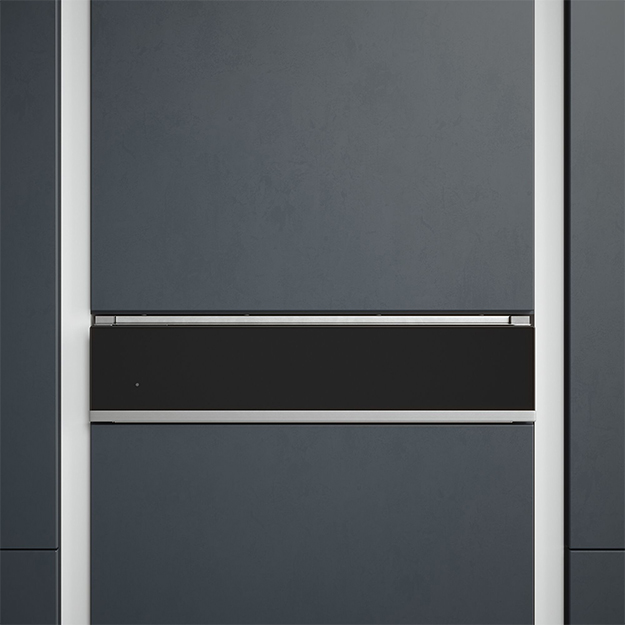
How do warming drawers work?
Warming drawers work by utilising advanced heating technology to create a controlled, evenly distributed heat source within the appliance. Here's how they operate:
Heating Element: Warming drawers are equipped with a heating element, typically located at the bottom of the drawer. This element generates the heat necessary to warm the contents.
Thermostat and Temperature Control: The appliance features a thermostat and temperature control settings that allow you to choose the desired temperature for your food. Most warming drawers have a temperature range of 27°C to 93°C.
Insulation: Warming drawers are well-insulated to ensure that the heat is evenly distributed and maintained throughout the interior space. This insulation prevents heat loss and keeps the contents warm.
Moisture Control: Some high-end warming drawers include moisture control features that enable you to maintain the moisture level in your food, preventing it from drying out.
Timer and Delay Start: Many warming drawers also come with timers and delay start functions, allowing you to set when the warming process begins and how long it continues, making meal planning and timing more convenient.
In summary, warming drawers are a crucial asset in the kitchen, designed to preserve the quality and warmth of your dishes until they're ready to be savoured. With their precise temperature control and advanced technology, they have revolutionised the art of meal preparation and presentation. In the following sections of our guide, we will explore their various uses, features, and maintenance tips to help you make the most of this remarkable kitchen appliance.
Pros and cons of warming drawers
Warming drawers are a valuable addition to any kitchen, offering a range of benefits that can enhance your cooking and meal preparation experience. In this section, we'll explore the advantages (pros) of having a warming drawer in your kitchen, as well as some potential drawbacks (cons). Additionally, we'll highlight scenarios where warming drawers can be particularly useful.
Advantages of having a warming drawer
Food Preservation:
- Pro: Warming drawers excel at preserving the warmth and moisture of cooked dishes without overcooking them. Your meals will stay at the perfect serving temperature until you're ready to enjoy them.
Convenient Meal Timing:
- Pro: When you're preparing multiple courses or hosting dinner parties, warming drawers allow you to time your dishes perfectly. You can prepare each course in advance and keep it warm until you're ready to serve.
Versatile Uses:
- Pro: Warming drawers aren't just for keeping food warm. They can also be used for proofing bread and dough, thawing frozen items, and even slow cooking, making them a versatile kitchen tool.
Enhanced Food Quality:
- Pro: Your food will retain its flavour, texture, and overall quality when stored in a warming drawer. There's no need to worry about dishes becoming soggy or drying out.
Stress-Free Entertaining:
- Pro: When entertaining guests, a warming drawer reduces the stress of coordinating meal timing. You can focus on socialising without rushing to serve hot dishes.
Moisture Control (Select Models):
- Pro: Some warming drawers offer moisture control features, allowing you to keep food moist and prevent it from drying out, especially beneficial for roasts and baked goods.
Energy Efficiency:
- Pro: Warming drawers are energy-efficient because they use lower wattage compared to conventional ovens or stovetops. They can also help you save energy by allowing you to prepare dishes in advance.
Disadvantages of having a warming drawer:
Cost:
- Con: Warming drawers can be relatively expensive to purchase and install, adding to your kitchen renovation or appliance budget.
Limited Cooking Functions:
- Con: While they are versatile, warming drawers are primarily designed for keeping food warm and may not replace the functionality of a full oven or microwave for cooking or reheating.
Space Requirements:
- Con: Warming drawers require dedicated space in your kitchen design, which may not be feasible for all kitchen layouts.
Energy Consumption (if used excessively):
- Con: If used excessively, warming drawers can contribute to higher energy bills. However, their energy efficiency offsets this to some extent.
Scenarios where warming drawers are particularly useful
Entertaining Guests: When hosting gatherings, warming drawers are invaluable for keeping appetisers, side dishes, and even desserts warm while you focus on hosting.
Multi-Course Meals: Preparing multi-course meals becomes more manageable with a warming drawer. You can cook and keep each course warm until it's time to serve.
Baking and Proofing: Bakers find warming drawers handy for proofing dough, allowing bread to rise effectively.
Holiday Cooking: During holiday feasts, a warming drawer can help you manage the timing of various dishes, ensuring everything is served hot.
Family Meal Planning: For busy families, warming drawers enable you to prepare meals ahead of time, so dinner is ready when everyone is.
Catering and Professional Cooking: In professional kitchens or catering settings, warming drawers are indispensable for keeping large quantities of food at the right temperature.
In conclusion, warming drawers offer several advantages in the kitchen, from preserving food quality to simplifying meal preparation. While they come with a few considerations, their versatility and convenience make them an asset for those who love to cook, entertain, or simply enjoy hot, well-timed meals.
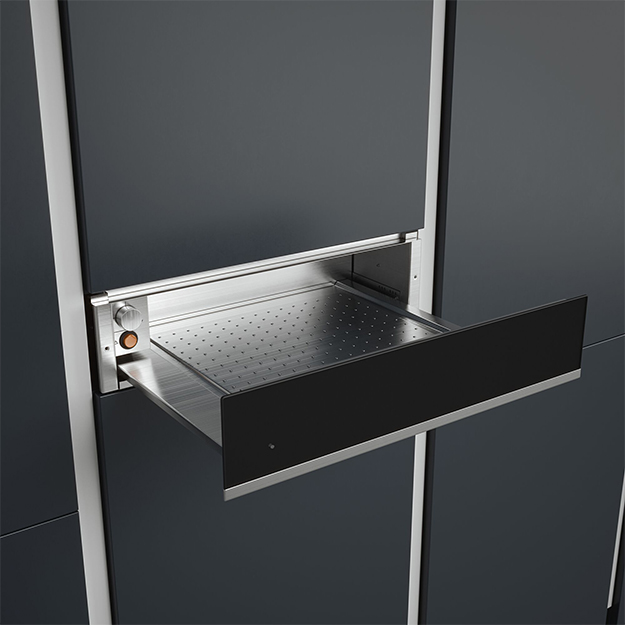
What types of warming drawers are available?
Integrated warming drawers
Built-in warming drawers are highly popular in residential kitchens, especially in upscale homes and those with custom-designed kitchen spaces. Here are some key reasons why built-in models are commonly chosen for residential use:
Aesthetic Integration: Built-in warming drawers are designed to seamlessly integrate with the kitchen cabinetry and appliances. This integration provides a cohesive and polished look, enhancing the overall aesthetics of the kitchen. They often have custom panels that match the cabinetry, creating a unified appearance.
Luxury and Elegance: Homeowners who prioritise the aesthetics and luxury of their kitchen spaces often opt for built-in warming drawers. They complement high-end kitchen designs and offer a sense of sophistication.
Permanent Placement: Since built-in models are intended for permanent placement within cabinetry, they are ideal for homeowners who plan to stay in their homes for an extended period. They become an integral part of the kitchen layout.
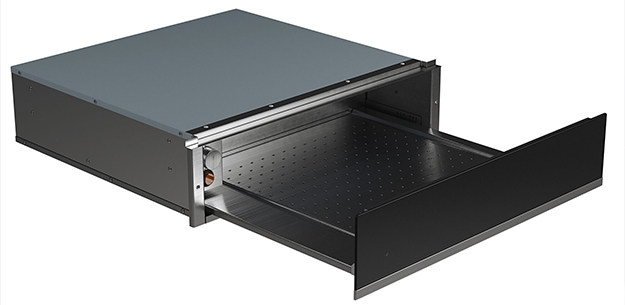
Freestanding and countertop Warming drawers
While built-in warming drawers are prevalent in residential kitchens, freestanding and countertop models are more commonly found in commercial settings for the following reasons:
Flexibility and Portability: In commercial kitchens, the layout and requirements often change, and flexibility is key. Freestanding and countertop warming drawers can be moved to different locations as needed, allowing chefs to adapt to evolving kitchen layouts and operational needs.
Ease of Installation: Commercial kitchens need to set up and rearrange their equipment quickly. Freestanding and countertop warming drawers are easy to install without the need for extensive modifications to kitchen infrastructure.
Outdoor Use: Some freestanding models are designed for outdoor use, making them ideal for outdoor kitchens, catering events, or barbecue areas in commercial settings. They offer versatility beyond the confines of indoor kitchens.
Variety of Sizes: Commercial kitchens often require larger warming capacities, and freestanding models can accommodate larger quantities of food, making them suitable for high-volume cooking and catering.
In summary, built-in warming drawers are popular in residential kitchens due to their aesthetic integration and luxurious appeal. On the other hand, freestanding and countertop models are more commonly used in commercial settings because they offer flexibility, ease of installation, and versatility, making them well-suited for the dynamic and diverse needs of professional chefs and catering operations.
| Type of Warming Drawer | Features | Benefits |
|---|---|---|
| Built-in Warming Drawers | Seamless Integration | Aesthetic Appeal |
| Customization | Quick Access to Warm Dishes | |
| Space-Saving | ||
| Freestanding Warming Drawers | Stand-Alone Units | Easy Installation |
| Mobility | Versatile Placement | |
| Variety of Sizes | Outdoor Use (some models) | |
| Countertop Warming Drawers | Compact Design | Space-Efficient |
| Plug-and-Play | No Hassle Installation | |
| Portable |
In summary, the type of warming drawer you choose depends on your kitchen design, available space, and personal preferences. Built-in models offer a polished look, freestanding models provide flexibility, and countertop models are space-efficient and easy to set up. Consider your kitchen's layout and your cooking habits when selecting the most suitable type for your needs.
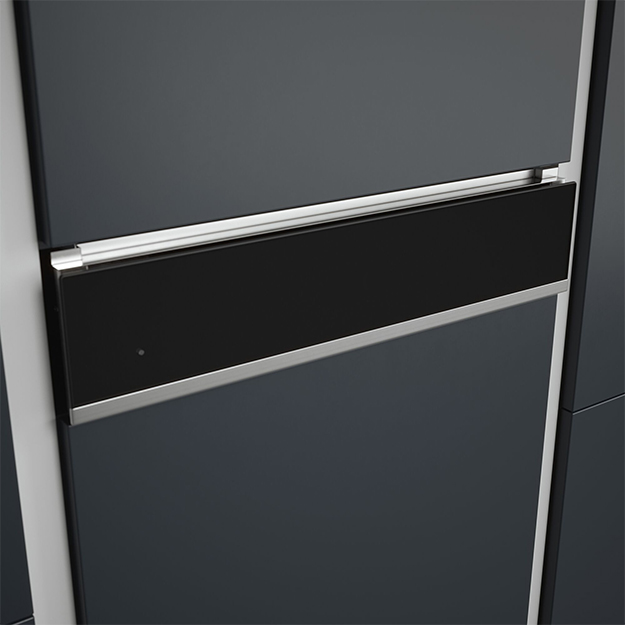
Warming drawers size and install
Choosing the right size and properly installing your warming drawer is crucial to ensure it functions efficiently and fits seamlessly into your kitchen. In this section, we'll provide guidance on selecting the appropriate size and walk you through the installation process, including electrical requirements and placement considerations.
Choosing the right size:
- Measure the available space in your kitchen, including width, height, and depth.
- Consider your capacity needs based on your cooking and entertaining habits.
- Warming drawers typically come in standard widths of 60 centimetres, but dimensions may vary between brands.
- Ensure there is adequate clearance around the warming drawer as per the manufacturer's guidelines.
Installation process:
Electrical Requirements:
- Consult an electrician to confirm your kitchen has the appropriate electrical wiring and sockets for the warming drawer.
- Verify the voltage and amperage requirements specified in the manufacturer's installation manual.
Placement Considerations:
- Choose a convenient location for your warming drawer, often near the oven or the main cooking area.
- Ensure the unit is installed on a level surface.
- Follow the manufacturer's guidelines for clearances and ventilation.
Cabinet Cut-out:
- For built-in warming drawers, create a cabinet cut-out matching the unit's dimensions using the manufacturer's template.
- Allow for proper ventilation and follow recommended clearances.
Securing the Unit:
- Secure the warming drawer within the cabinet cut-out using provided screws or brackets.
Connecting to Power:
- Connect the unit to a dedicated electrical circuit as per the manufacturer's wiring instructions, usually requiring the expertise of a licensed electrician.
Ventilation:
- Ensure proper ventilation according to the manufacturer's requirements, which may involve external venting or internal fan circulation.
Testing:
- After installation, test the warming drawer to ensure it heats up and maintains the desired temperature accurately.
Final Adjustments:
- Make any necessary adjustments to level and align the warming drawer within the cabinet.
By following these guidelines, you can choose the right size and install your warming drawer effectively, ensuring it operates safely and efficiently in your kitchen. If you have any uncertainties regarding installation, consider seeking assistance from a professional installer or technician.
Temperature control and settings on warming drawers
Warming drawers offer precise temperature control and a range of settings to help maintain the warmth and quality of your dishes. Let's explore the temperature control options and pre-set settings commonly found in these appliances.
Temperature range:
Warming drawers typically encompass a temperature range of approximately 27°C to 93°C. This broad spectrum allows for the customization of temperatures to suit the specific needs of your dishes. The temperature control features are as follows:
Adjustable Temperature Control:
Most warming drawers feature user-friendly temperature adjustment dials or digital controls. These controls empower you to set the desired temperature within the specified range.
Precise Temperature Settings:
High-quality warming drawers offer precise temperature settings, typically in 1°C or 2°C increments. This precision proves invaluable when maintaining the exact warmth of delicate dishes.
Pre-set temperature settings:
Many warming drawers are equipped with pre-set temperature settings, each tailored to specific types of food or functions. These pre-sets enhance the convenience and versatility of the appliance. Here are some common pre-set temperature settings and their applications:
Low Heat Setting (27°C to 43°C):
Ideal for keeping delicate dishes, such as seafood or desserts, warm without overcooking or drying them out.
Medium Heat Setting (60°C to 77°C):
Suitable for holding most cooked dishes, such as casseroles, roasted meats, or sides, at an optimal serving temperature.
High Heat Setting (82°C to 93°C):
Perfect for more robust dishes like stews, soups, or hearty mains, ensuring they remain hot and ready for serving.
Proofing Setting (Approximately 32°C to 38°C):
Crafted for bakers, this setting creates an ideal environment for proofing bread and dough, allowing yeast to rise effectively.
Thawing Setting (Variable):
Some warming drawers offer a thawing setting that gently and safely thaws frozen food items without the risk of overcooking.
Slow Cooking Setting (Variable):
Certain high-end warming drawers include a slow cooking option, allowing you to cook dishes over an extended period at lower temperatures. This can be particularly useful for preparing braises and stews.
Moisture Control Settings (Some Models):
A select few warming drawers offer moisture control settings to regulate the humidity level within the drawer, preventing dishes from drying out. This is especially valuable for items like roasted meats and baked goods.
Custom temperature settings:
In addition to pre-set temperature options, warming drawers often allow you to set custom temperatures based on your specific requirements. This flexibility permits you to tailor the warming drawer's performance to the unique needs of your dishes, ensuring they are served at their best.
By understanding the temperature control and pre-set settings of your warming drawer, you can effectively utilise this appliance to keep your food warm, moist, and ready to serve, all while preserving its flavour and texture.
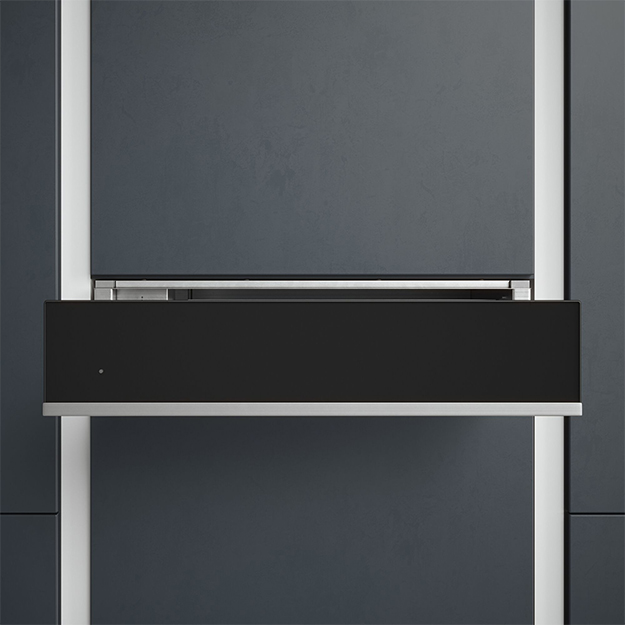
Cleaning and maintenance of a warming drawer
Proper cleaning and maintenance are crucial to ensure your warming drawer operates efficiently and lasts for many years. Here are some valuable tips to help you keep your warming drawer in top condition:
Regular cleaning:
Power Off and Cool Down: Always switch off the warming drawer and allow it to cool down completely before beginning the cleaning process. This ensures safety and prevents burns.
Remove Food Debris: After each use, clear away any food crumbs, spills, or residue from the warming drawer's interior. Use a soft, damp cloth or sponge to wipe away these particles.
Clean Removable Components: If your warming drawer has removable racks, pans, or trays, take them out and wash them separately. Use warm, soapy water and a non-abrasive sponge to clean these components. Rinse and dry them thoroughly before placing them back into the drawer.
Interior Cleaning: To clean the interior, use a mixture of warm water and mild dish soap. Apply the solution to a soft cloth or sponge and gently wipe the interior surfaces, including the sides and bottom. Avoid using abrasive or harsh cleaning agents that may damage the interior.
Stainless Steel Surfaces: If your warming drawer features stainless steel surfaces, use a stainless steel cleaner to maintain their shine. Wipe in the direction of the grain to prevent scratching.
Occasional Maintenance:
Check Seals and Gaskets: Periodically inspect the door seals and gaskets for any signs of wear, tears, or damage. Damaged seals can compromise the warming drawer's efficiency. Replace them if necessary to maintain a proper seal.
Ventilation: Ensure that the vents and fans, if applicable, are free from dust and debris. Clogged vents can obstruct airflow and affect the drawer's performance. Use a soft brush or vacuum cleaner to remove any build-up.
Electrical Components: While the warming drawer is powered off, examine the electrical cord and plug for any signs of damage or wear. If you notice any issues, contact a qualified technician or electrician for repairs.
Long term care:
Routine Inspections: Periodically, inspect the warming drawer for any loose screws, damaged knobs, or malfunctioning controls. Tighten or replace components as needed.
Calibration: If you suspect that the warming drawer's temperature settings are no longer accurate, consider calibrating it. Consult the manufacturer's instructions for guidance on recalibrating the temperature control.
User Manual: Always refer to the manufacturer's user manual for specific cleaning and maintenance instructions tailored to your warming drawer model.
Professional Servicing: If you encounter any issues with the warming drawer's performance or safety features, do not attempt to repair it yourself. Contact a qualified appliance technician or the manufacturer's customer service for professional servicing and repairs.
By following these cleaning and maintenance tips, you can ensure that your warming drawer operates optimally, prolong its lifespan, and enjoy the convenience it brings to your kitchen for years to come.
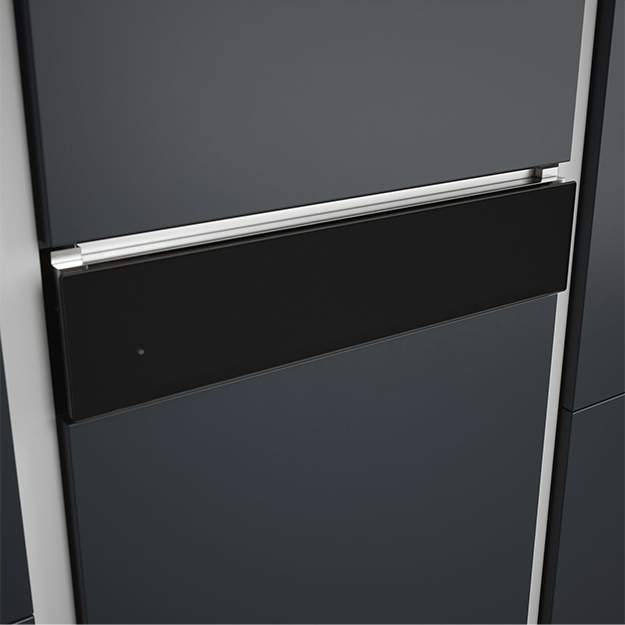
Common faults and troubleshooting issues for warming drawers
Warming drawers, like any kitchen appliance, may encounter occasional issues that can affect their performance. Here are some common problems you may encounter with warming drawers and steps to troubleshoot and resolve them:
Warming Drawer Not Heating
Uneven Heating
Drawer Not Sliding Smoothly
Excessive Moisture Build-up
Unusual Odours
Excessive Noise
Error Codes or Malfunctions (Digital Models)
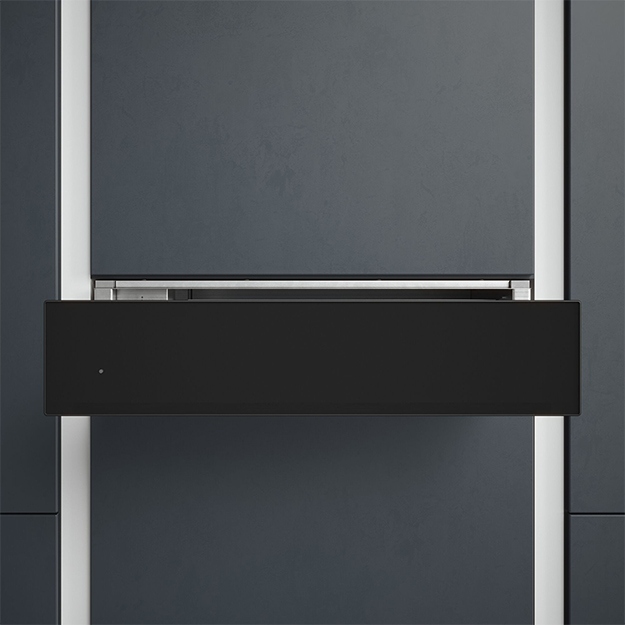
Safety considerations with warming drawers
Warming drawers are handy kitchen appliances designed to keep food warm and maintain its temperature until it's ready to be served. While they can be convenient, it's essential to follow safety precautions to prevent accidents and mishaps when using them. Here are some safety guidelines and tips to ensure safe operation:
Read the User Manual
Always start by reading the manufacturer's user manual that comes with your warming drawer. This document provides specific instructions and safety information related to your appliance.
Proper Installation
Ensure that your warming drawer is installed correctly and securely. If it's not installed properly, it could pose a safety hazard. Seek professional installation if needed.
Placement Place
the warming drawer in a location where it won't obstruct the flow of traffic in the kitchen. Make sure it's positioned away from flammable materials, such as curtains, paper towels, or plastic containers.
Temperature Control
Understand how to control and adjust the temperature settings on your warming drawer. Most warming drawers allow you to set specific temperatures to keep your food warm without overcooking.
Use Appropriate Cookware
Use heat-resistant and oven-safe cookware and containers when placing food in the warming drawer. Avoid using plastic or materials not designed for high temperatures, as they can melt or release harmful chemicals.
Avoid Overcrowding
Don't overcrowd the warming drawer with too much food or cookware. Overloading can hinder the appliance's ability to maintain even temperatures and might lead to uneven warming.
Preheat if Necessary
Some warming drawers require preheating to reach the desired temperature. Be sure to follow the manufacturer's recommendations for preheating, if applicable.
Monitor Food Temperature
Use a food thermometer to check the internal temperature of the food periodically. This ensures that the food stays at a safe temperature to prevent bacterial growth.
Child Safety
If you have children in the house, consider childproofing your warming drawer. Many models come with child locks or safety features to prevent accidents.
Unplug When
Not in Use When you're done using the warming drawer, unplug it or turn it off to prevent accidents and save energy.
Regular Maintenance
Keep your warming drawer clean and free of food debris. Regularly clean the interior, racks, and any removable parts according to the manufacturer's instructions.
Ventilation
Ensure that the warming drawer has proper ventilation to prevent overheating. Don't block the vents or place items on top of the appliance.
Emergency Response
In case of a malfunction, electrical issue, or unusual odour, turn off the warming drawer immediately and unplug it. Contact a professional technician for repairs.
By following these safety precautions and practicing responsible use, you can minimise the risk of accidents and mishaps when using a warming drawer, making it a valuable and safe addition to your kitchen appliances. Always prioritise safety and be mindful of the specific guidelines provided by your warming drawer's manufacturer.
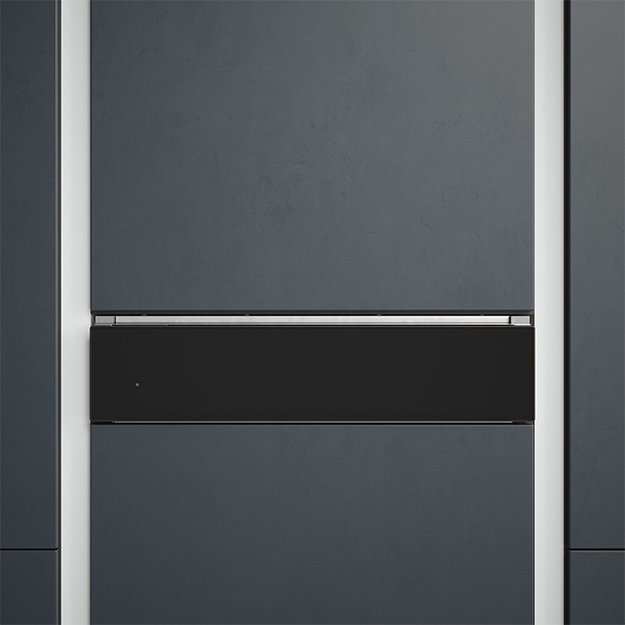
Warming drawer accessories
Accessories can significantly improve the functionality of your warming drawer, making it a more versatile and efficient kitchen appliance. Here are some essential accessories to consider:
Warming Racks:
- Warming racks provide additional storage space within the warming drawer, allowing you to stack multiple dishes or trays and keep various items warm simultaneously.
Warming Pans and Dishes:
- Specialised warming pans and dishes are designed to distribute heat evenly, ensuring that your dishes maintain their temperature and quality. They come in various sizes and shapes to accommodate different foods.
Food Liners:
- Liners or mats placed at the bottom of the warming drawer catch spills, crumbs, and drips, making clean-up easier and preventing food residue from sticking to the interior.
Temperature Probes:
- Compatible with some warming drawers, temperature probes help you monitor the internal temperature of dishes accurately. They ensure precise temperature control, particularly useful for dishes requiring specific heat levels.
Storage Containers:
- Airtight, heat-resistant storage containers can be used to store food in the warming drawer, preserving freshness and warmth until serving.
Plate Warmers:
- Plate warmers heat dinnerware before serving, enhancing the dining experience by ensuring that meals are served on warm plates.
Bread Proofing Drawer Inserts:
- Designed for warming drawers with bread proofing settings, these inserts create an ideal environment for bread and dough proofing, simplifying baking.
Temperature Control Accessories:
- Some warming drawers offer adjustable dividers or racks that allow you to customise the internal space or maintain separate temperature zones.
Timer and Delay Start Accessories:
- External timers or smart plugs can be used to control when the warming drawer turns on and off, ensuring dishes are ready precisely when needed.
Food Covers and Lids:
- Food covers or lids designed to fit warming pans and dishes help prevent moisture loss and maintain dish texture, preserving the quality of your food.
Select accessories that are compatible with your warming drawer model and made from materials that can withstand the appliance's heat. These additions will expand your warming drawer's capabilities, making it a valuable tool in your kitchen.
Energy consumption of warming drawers
Warming drawers are generally designed to be energy-efficient, but their consumption can vary depending on factors such as insulation and usage patterns. To use them efficiently and save energy, opt for models with higher energy efficiency ratings and ensure proper insulation and sealing to retain heat effectively. Set the drawer to the lowest temperature needed, avoid prolonged preheating, and maximise its use by loading dishes efficiently. Use timers to turn it off when no longer needed and perform regular maintenance for optimal performance. Lastly, consider energy-saving models with low-power modes or smart features for more efficient control. By following these tips, you can reduce the energy consumption of your warming drawer while still enjoying the convenience of keeping your dishes warm.
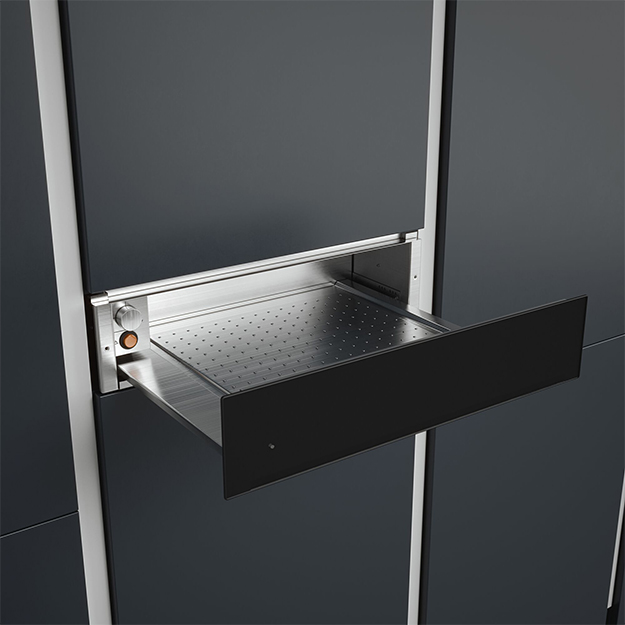
In conclusion
In this ultimate guide, we've covered all aspects of warming drawers, from their definition and functions to benefits, types, installation, usage, maintenance, and safety. Whether you're a passionate cook or a busy homeowner, a warming drawer can elevate your kitchen experience by ensuring perfectly warmed dishes.
We've examined the pros and cons, explained the different types, and provided temperature control tips for efficient usage. Troubleshooting and safety precautions have been discussed to ensure smooth and safe operation.
Lastly, we explored accessories that enhance functionality. With this guide, you now have a comprehensive understanding of warming drawers and how they can enhance your kitchen and dining experiences.
Frequently asked questions about warming drawers
What is a warming drawer, and how does it work?
- A warming drawer is a kitchen appliance designed to keep food warm and at a safe serving temperature. It works by gently applying low heat to the contents, preventing them from cooling down or drying out.
What are the primary uses of a warming drawer?
- Warming drawers are primarily used to keep cooked food warm until it's ready to be served. They are also useful for proofing bread dough, warming dishes and plates, and thawing frozen foods.
Are warming drawers the same as ovens or microwaves?
- No, warming drawers serve a specific purpose, which is to keep food warm. They do not cook or heat food like ovens or microwaves.
Can I cook or reheat food in a warming drawer?
- Warming drawers are not intended for cooking or reheating food to a safe temperature. They maintain the existing temperature of cooked food to keep it warm.
How do I clean and maintain a warming drawer?
- To clean a warming drawer, remove any crumbs or spills promptly and wipe the interior with a damp cloth. Refer to the user manual for specific cleaning instructions. Regular maintenance includes checking for loose components and ensuring proper ventilation.
Are warming drawers energy-efficient?
- Warming drawers are designed to be energy-efficient, but their consumption may vary depending on factors such as insulation and usage patterns. Following energy-saving tips, such as turning off the drawer when not in use, can help reduce energy consumption.
Can I install a warming drawer in any kitchen?
- In most cases, yes. Warming drawers come in various sizes and can be installed as built-in, freestanding, or countertop models. Ensure proper electrical requirements and adequate space for installation.
Are warming drawers safe to use around children?
- While warming drawers are generally safe, they can pose risks, especially to young children. It's essential to follow safety precautions, supervise children, and use child safety features if available.
What types of containers and dishes can I use in a warming drawer?
- Use heat-resistant, oven-safe dishes and containers suitable for the temperature settings of your warming drawer. Avoid using plastic containers that may melt or warp.
Can I proof bread dough in a warming drawer?
- Yes, warming drawers with a bread proofing function create an ideal environment for dough to rise. Follow the manufacturer's guidelines for proofing bread effectively.
Do warming drawers come with temperature controls?
- Yes, most warming drawers have adjustable temperature settings, allowing you to choose the desired level of warmth for your food.
Can I stack dishes in a warming drawer?
- Yes, warming drawers often come with multiple racks or levels, allowing you to stack dishes and maximize the use of space.
Are warming drawers noisy?
- No, warming drawers are typically quiet during operation. They produce minimal noise, making them suitable for use in quiet kitchens.
Can I retrofit an existing cabinet with a warming drawer?
- Retrofitting an existing cabinet with a warming drawer is possible but may require modifications to accommodate the appliance. Consult with a professional installer for guidance.
Can I use a warming drawer to keep food cold?
- Some warming drawers have a cooling function, allowing you to keep food cold as well. Check the specifications of your model to see if this feature is available.
Are there energy efficient models of warming drawers available?
- Yes, some warming drawers come with energy-saving features like low-power modes or timers to reduce energy consumption.
